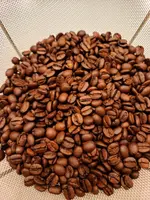Hey guys;
Please bear with me on this long post, as I have been doing some experimentation with my new 1ZPresso JX Pro grinder and fresh beans.
I hope that you understand I am still a newbie in the coffee brewing game. I am going to make mistakes, misunderstand the science of the process, and probably read some misleading info in online blogs. So here goes:
I chose a medium/dark roast (recommended by the shop where I purchased them). The beans were roasted on-site but I don't know exactly how long they were sitting in the bag; my guess would be not more than a couple of days. They smelled absolutely delicious when I first opened the bag.
I have been experimenting with the variables; mostly grind and brew time.
I purchased an electric kettle, which displays temperature just before I start adding water to the grounds in the FP.
For all of my brews so far, I have set the kettle to 194F.
I started with a setting of 45 on the 1ZPresso JX Pro. This is midway through the recommended grind for French Press. Finest is 42, coarsest is 50 - the max coarse setting for the grinder.
I used a ratio of 1:12.3, using 480g water and 39g coffee beans.
I brewed my first cup by the simple method - no blooming, but I did stir after adding all of the water.
I timed the steep for 4 minutes.
The result was that I could not really detect any of the aromas this coffee is supposed to have, but the taste was ok. I drank it black.
There wasn't much bitterness (or sourness) but I thought there should have been a bit more flavor.
For my 2nd brew, I changed the grinder to a slightly finer setting of 42 (vs 45), but i also changed the ratio to 1:13.5 (increasing water by 5g and decreasing coffee by 3g). I realize that I should not have changed two values at the same time, but this was only my 2nd brew with the fresh beans.
I steeped for 4 minutes, as before.
The coffee seemed slightly less bitter, but still not as much flavor as I thought it should have.
I have been tweaking the steep time over the past few days, and getting some confusing results.
It seemed that when I decreased steep time, while keeping grind and ratio the same, I was getting a more bitter cup. This seemed contrary to what I have been reading.
I was thinking that a shorter brew time would produce less bitterness.
Then I got the idea to go a bit finer with the grind, notching the JX Pro down to 40. This is out of the range for FP (according to the 1ZPresso chart that was included with the grinder), but I figured that I didn't mind some fines in my cup.
At the same time I ground finer, I also reduced time to 3:00.
This seemed to produce a cup that was less bitter, and with a bit more flavor.
Today, I decided to do some experimentation with smaller amounts of coffee and water.
Grind: 45 (coarse)
Water: 120g
Coffee: 9.2g
Ratio: 1:13
Water temp: 194F
After reading this blog:
https://angelscup.com/blog/taste/coffee-extraction-sour-vs-bitter/
I began experimenting with steep time; no bloom, but stirring after all water had been added.
The purpose of this experiment was to detect the difference between bitter and sour. I feel that I have been confused about this.
4:00. Some bitterness (or was it sourness), but not too bad.
8:00. Very bitter, yuk.
2:00 sour
5:00: Now I can smell some citrus aroma from the cup, but I cannot taste it.
I believe I can now tell the difference between bitter and sour. This should go a long way in helping me dial-in the settings.
As I now understand it, under-extraction causes sour, while over-extraction causes bitter.
Now another point I am confused about:
Until now, I have believed that when using a finer grind, you need to reduce steep time to prevent bitterness. The reason being that more surface area of the ground bean is exposed to the water, thus extraction will occur more rapidly.
But further down the page in the same blog I linked to above it states that a finer grind will slow down the extraction process. This is exactly the opposite of what I was lead to believe from other blogs and videos I have seen.
That said, James Hoffman does a 9 minute brew with finer grounds. But since he is scooping off the foam and whatever doesn't sink after stirring at 4:00, I don't think I can really compare his method to the more simple one so far as time goes.
At this point, I am somewhat confused, but still very interested in this process, and 'dialing-in' my perfect cup from the French Press. In my younger days, I might have given up in frustration, but I have a lot more patience now that I am older (and hopefully wiser). Doing the experimentation with much smaller brews has helped me understand what I am doing, without wasting too much coffee or getting me too jacked up on caffeine. Yes, I am drinking the coffee I brew during my experimentation.
Thank you for reading. I greatly appreciate all of the good advice you guys are giving me.
Ultrarunner
